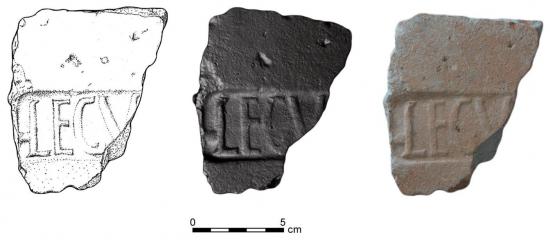PART.2
Consulting the Sacred Eagle
The 2017 summer excavation season unearthed the monumental gate to the military base headquarters, the so-called principia.
The principia was the heart of the Roman military base, a huge complex some 100 meters by 100 meters. Grand in size and in design, it had a huge colonnaded façade as well as a grand colonnade inside.
“The principia was not just the legionary commander’s headquarters; it was also the legion’s shrine. It included an open courtyard that housed a sanctuary for the legion’s standards, the revered symbol of the unit,” Strauss told Haaretz.
The sacred eagle of the legion, which was venerated during daily activities, was held in a room in the back center. When a commander or a priest was performing aguere, i.e., consulting the birds, hoping for omens in preparation for battle, all was performed in the principia. How the birds' vocalizations were interpreted is not clear.
The principia was also the site of the treasury, the armory, and was where the scribes worked.
 Clay pipes in situ, used for the drinking water supplies to buildings in the Legionary base at Legio Yotam Tepper
Clay pipes in situ, used for the drinking water supplies to buildings in the Legionary base at Legio Yotam Tepper
In front of the gate, the archaeologists found a stone mark, a typical decoration on the the principia façade – and a dedicatory inscription. “The inscription contains several names, all with the name Flavius in them,” Teppers says, adding that the inscription is badly damaged and broken, and is still undergoing investigation – which doesn't stop us from speculating that inscription could have been erected to mark the building's construction. It could be listing camp commanders, or celebrating heroes of the Sixth Legion, Adams suggests.
Latrines yield golden nuggets
Another remarkable find was the discovery of the military headquarters' latrines, which, whatever else they had held, were rich in material. Mainly, in the sewers underneath the latrine, the excavators found numerous Roman coins, as well as glass, pottery and animal bones. No, they had not been excreted. “This is where much of the garbage of the camp inevitably ended up,” Adams explains.
Over 200 Roman coins dating to the 2nd and 3rd century C.E. have been unearthed in the dig.
The excavators also found a man-made cave dug inside the Legio base. Inside it, they found a Roman cooking pot with the remains of a cremated individual, probably a soldier.
“Cremation burials in cooking pots were a common practice among Roman soldiers at that time. We found this kind of burial all around the site," Tepper told Haaretz.
 tile bearing the stamp of the Sixth Legion Ferrata Jezreel Valley Regional Project
tile bearing the stamp of the Sixth Legion Ferrata Jezreel Valley Regional Project
Finding one's final resting place in a cooking pot was not atypical of Roman burial practices at other Roman military sites, in Israel and around the Mediterranean, Tepper added.
Excavations in previous seasons, in 2013 and 2015, unearthed large numbers of ceramic roofing tiles bearing the mark of the Sixth Ironclad Legion, and even some bearing the footprints from the legendary legionnaires' sandals.
The archaeologists also found fragments of scale armor, hollow headed nails that had been attached to the soldiers' sandals, clay pipes, sewer channels, and several buildings, all of which attest to the high level of planning at the site.
Its end was well planned too. Towards the end of the 3rd century C.E., during the reign of Diocletian, the Ironclad Legion was redeployed to the eastern frontier and the base was decommissioned and dismantled.